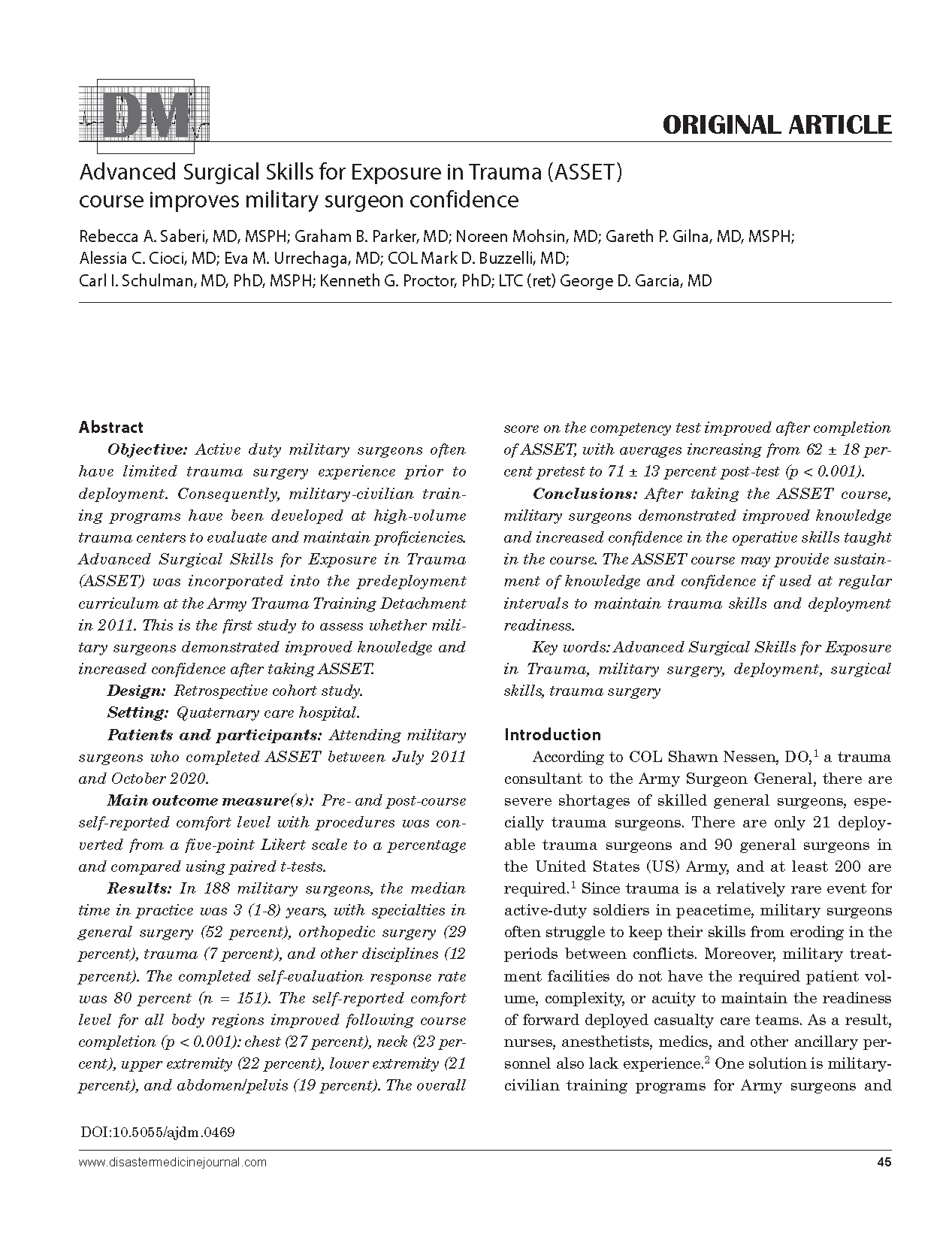Advanced Surgical Skills for Exposure in Trauma (ASSET) course improves military surgeon confidence
DOI:
https://doi.org/10.5055/ajdm.0469Keywords:
Advanced Surgical Skills for Exposure in Trauma, military surgery, deployment, surgical skills, trauma surgeryAbstract
Objective: Active duty military surgeons often have limited trauma surgery experience prior to deployment. Consequently, military-civilian training programs have been developed at high-volume trauma centers to evaluate and maintain proficiencies. Advanced Surgical Skills for Exposure in Trauma (ASSET) was incorporated into the predeployment curriculum at the Army Trauma Training Detachment in 2011. This is the first study to assess whether military surgeons demonstrated improved knowledge and increased confidence after taking ASSET.
Design: Retrospective cohort study.
Setting: Quaternary care hospital.
Patients and participants: Attending military surgeons who completed ASSET between July 2011 and October 2020.
Main outcome measure(s): Pre- and post-course self-reported comfort level with procedures was converted from a five-point Likert scale to a percentage and compared using paired t-tests.
Results: In 188 military surgeons, the median
time in practice was 3 (1-8) years, with specialties in general surgery (52 percent), orthopedic surgery (29 percent), trauma (7 percent), and other disciplines (12 percent). The completed self-evaluation response rate was 80 percent (n = 151). The self-reported comfort level for all body regions improved following course completion (p < 0.001): chest (27 percent), neck (23 percent), upper extremity (22 percent), lower extremity (21 percent), and abdomen/pelvis (19 percent). The overall score on the competency test improved after completion of ASSET, with averages increasing from 62 ± 18 percent pretest to 71 ± 13 percent post-test (p < 0.001).
Conclusions: After taking the ASSET course, military surgeons demonstrated improved knowledge and increased confidence in the operative skills taught in the course. The ASSET course may provide sustainment of knowledge and confidence if used at regular intervals to maintain trauma skills and deployment readiness.
References
Nessen SC: Why we need to draft trauma surgeons. American College of Surgeons. Updated 2017. Available at https://www.facs.org/-/media/files/quality-programs/trauma/zpd-conf/21_nessen.ashx. Accessed June 21, 2021.
Tadlock MD, Carr M, Diaz J, et al.: How to maintain the readiness of forward deployed caregivers. J Trauma Acute Care Surg. 2021; 90(5): e87-e94. DOI: https://doi.org/10.1097/TA.0000000000003054
Bell RH, Jr: Why Johnny cannot operate. Surgery. 2009; 146(4): 533-542. DOI: https://doi.org/10.1016/j.surg.2009.06.044
Kuhls DA, Risucci DA, Bowyer MW, et al.: Advanced surgical skills for exposure in trauma: A new surgical skills cadaver course for surgery residents and fellows. J Trauma Acute Care Surg. 2013; 74(2): 664-670. DOI: 10.1097/TA.0b013e31827d5e20. DOI: https://doi.org/10.1097/TA.0b013e31827d5e20
Bowyer MW, Kuhls DA, Haskin D, et al.: Advanced surgical skills for exposure in trauma (ASSET): The first 25 courses. J Surg Res. 2013; 183(2): 553-558. DOI: 10.1016/j.jss.2013.02.005. DOI: https://doi.org/10.1016/j.jss.2013.02.005
Mackenzie CF, Garofalo E, Shackelford S, et al.: Using an individual procedure score before and after the advanced surgical skills exposure for trauma course training to benchmark a Hemorrhage-Control performance metric. J Surg Educ. 2015; 72(6): 1278-1289. DOI: 10.1016/j.jsurg.2015.06.009. DOI: https://doi.org/10.1016/j.jsurg.2015.06.009
Shackelford S, Garofalo E, Shalin V, et al.: Development and validation of trauma surgical skills metrics: Preliminary assessment of performance after training. J Trauma Acute Care Surg. 2015; 79(1): 105-110. DOI: 10.1097/TA.0000000000000685. DOI: https://doi.org/10.1097/TA.0000000000000685
Mackenzie CF, Shackelford SA, Tisherman SA, et al.: Critical errors in infrequently performed trauma procedures after training. Surgery. 2019; 166(5): 835-843. DOI: 10.1016/j.surg.2019.05.031. DOI: https://doi.org/10.1016/j.surg.2019.05.031
Breeze J, Combes JG, DuBose J, et al.: How are we currently training and maintaining clinical readiness of US and UK military surgeons responsible for managing head, face and neck wounds on deployment? J R Army Med Corps. 2018; 164(3): 183-185. DOI: 10.1136/jramc-2018-000971. DOI: https://doi.org/10.1136/jramc-2018-000971
Dubose J, Rodriguez C, Martin M, et al.: Preparing the surgeon for war: Present practices of US, UK, and Canadian militaries and future directions for the US military. J Trauma Acute Care Surg. 2012; 73(6 Suppl. 5): S423-S430. DOI: https://doi.org/10.1097/TA.0b013e3182754636
Thorson CM, Dubose JJ, Rhee P, et al.: Military trauma training at civilian centers: A decade of advancements. J Trauma Acute Care Surg. 2012; 73(6 Suppl. 5): S483-S489. DOI: https://doi.org/10.1097/TA.0b013e31827546fb
Gunst M, O’Keeffe T, Hollett L, et al.: Trauma operative skills in the era of nonoperative management: The trauma exposure course (TEC). J Trauma. 2009; 67(5): 1091-1096. DOI: https://doi.org/10.1097/TA.0b013e3181bc77ba
Homma H, Oda J, Yukioka T, et al.: Effectiveness of cadaver-based educational seminar for trauma surgery: Skills retention after half-year follow-up. Acute Med Surg. 2017; 4(1): 57-67. DOI: 10.1002/ams2.230. DOI: https://doi.org/10.1002/ams2.230
Mackenzie CF, Garofalo E, Puche A, et al.: Performance of vascular exposure and fasciotomy among surgical residents before and after training compared with experts. JAMA Surg. 2017; 152(6): 581-588. DOI: 10.1001/jamasurg.2017.0092. DOI: https://doi.org/10.1001/jamasurg.2017.0092
Mackenzie CF, Tisherman SA, Shackelford S, et al.: Efficacy of trauma surgery technical skills training courses. J Surg Educ. 2019; 76(3): 832-843. DOI: 10.1016/j.jsurg.2018.10.004. DOI: https://doi.org/10.1016/j.jsurg.2018.10.004
Frye AW, Hemmer PA: Program evaluation models and related theories: AMEE Guide no. 67. Med Teach. 2012; 34(5): e288-99-e299. DOI: 10.3109/0142159X.2012.668637. DOI: https://doi.org/10.3109/0142159X.2012.668637
Sussman MS, Ryon EL, Urrechaga EM, et al.: The key to combat readiness is a strong military-civilian partnership. Mil Med. 2021; 186(5-6): 571-576. DOI: 10.1093/milmed/usaa565. DOI: https://doi.org/10.1093/milmed/usaa565
Eastridge BJ, Costanzo G, Jenkins D, et al.: Impact of joint theater trauma system initiatives on battlefield injury outcomes. Am J Surg. 2009; 198(6): 852-857. DOI: 10.1016/j.amjsurg.2009.04.029. DOI: https://doi.org/10.1016/j.amjsurg.2009.04.029
Schreiber MA, Holcomb JB, Conaway CW, et al.: Military trauma training performed in a civilian trauma center. J Surg Res. 2002; 104(1): 8-14. DOI: 10.1006/jsre.2002.6391. DOI: https://doi.org/10.1006/jsre.2002.6391
Rosenfeld JV: How will we produce the next generation of military surgeons? Re: Skill sets and competencies for the modern military surgeon: Lessons from UK military operations in Southern Afghanistan. Injury. 2010; 41(5): 435-436. DOI: 10.1016/j.injury.2010.01.004. DOI: https://doi.org/10.1016/j.injury.2010.01.004

Published
How to Cite
Issue
Section
License
Copyright 2007-2025, Weston Medical Publishing, LLC and American Journal of Disaster Medicine. All Rights Reserved.

